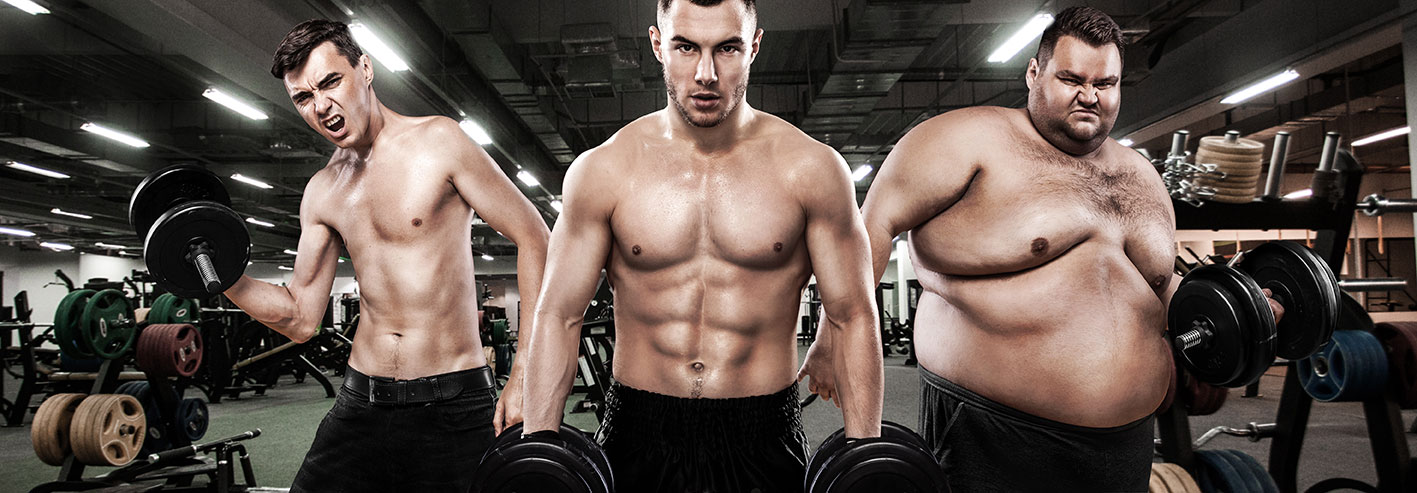HOW YOUR BODY TYPE AFFECTS FAT LOSS
Posted: 05/12/2020 by Steven Lokwan Ph.D.

It’s plain to see that we come in a number of shapes and sizes; however, even with such diversity we can ‘shoehorn’ everyone into one of three general body-types known as ‘somatotypes’:
- Ectomorph
- Mesomorph
- Endomorph
In reality, this is an oversimplification since the majority of individuals have, to varying degrees, ectomorph/mesomorph or mesomorph/endomorph traits, but for the purpose of this discussion (and our sanity), we’ll discuss each somatotype in isolation.
However, before we discuss fat loss for each somatotype we must first consider ‘body composition’. This term describes the relative proportion of fat, bone, water and muscle in your body, and is a far more useful measure of progress when it comes to fat loss compared to the ‘dreaded’ scales because it is not subject to daily fluctuations in the same way your weight is. Typically, for females, the ideal range for percentage body-fat is 14% to 31%, whilst for males, it is 6% to 24% with the lower ranges best describing the ideal for younger individuals and the upper ranges best describing the ideal for older individuals.
In addition, your fitness goals also will determine where your ideal percentage body-fat will sit in these ranges. For example, the ideal for a competitive endurance athlete will be on the lower end of the scale, or even perhaps slightly below the minimum. However, it’s important to note that you should never shoot for zero percentage body-fat (in fact, this is impossible if you want to stay alive), and anything below 5% should be considered unhealthy for the majority of individuals.
So now let’s consider the characteristics of each somatotype and how approaches to fat-loss differ for each.

ECTOMORPHS
These individuals have a slender build with long limbs and do not typically possess a muscular physique. On the face of it, fat-loss may not appear to be a pressing concern; however, these individuals can still be ‘skinny fat’ where they have a high percentage of body-fat compared to muscle. Women have a greater tendency to be skinny fat than men because they naturally carry more body-fat as well as individuals who have lost weight through dieting without exercising.
Ectomorphs are the most resistant to overall weight gain, both in terms of putting on lean mass (muscle) and non-lean mass (fat), due to a fast metabolism. So whilst many non-ectomorphs may secretly (or not so secretly) envy ectomorphs being able to devour anything they like without gaining much weight, the downside of this somatotype is that it is also difficult for them to develop a strong athletic physique let alone maintain one.
Physical training simply results in an already fast basal metabolic rate increasing even further, and so to reap the most out of their efforts, ectomorphs should focus on power training (e.g. plyometric, ballistic and contrast training) and resistance training using low to moderate rep ranges and moderate to heavy loads. Long steady-state endurance training and high-intensity interval training (HIIT), whilst perfectly good training protocols in their own right, simply raise the metabolic rate of ectomorphs to a level where they will simply ‘burn’ off all their efforts.
In order to maximize body composition, namely to increase lean-mass and reduce body-fat, any training program must be accompanied by an appropriate diet. Ectomorphs need to eat a sufficient amount of good quality fats (unsaturated fats) and carbohydrates (both non-starchy and starchy carbohydrates), both of which are great energy sources with moderate protein intake (25g - 30g per meal). The standard recommended calorific intake of 2,500kcal and 2,000kcal for males and females respectively is likely to be too low for most ectomorphs; depending on fitness goals these recommendations could be increased by as much as 500kcal to 1,000kcal. These additional calories can be eaten as part of main meals or snacks, and also as pre-workout/post-workout snacks on training days when the extra calories are needed the most. Ultimately, the exact calorie intake to shoot for is determined by a number of variables that are very specific to each individual, and so it is important to note what is eaten and monitor the results. If lean-mass decreases, calorific intake should be increased; if body-fat increases, calorific intake should be decreased.
MESOMORPHS
Mesomorphs can lose body-fat and build lean-mass relatively easy and so can maintain a healthy body composition with the least amount of effort compared to the other somatotypes. Their torsos tend to be long and their limbs short, but overall they are proportionally built. Male mesomorphs tend to have broad shoulders and small waists creating the often desired v-shaped torso, whilst female mesomorphs appear strong and athletic.
In many respects, the mesomorph somatotype represents the ideal for power and speed sports (e.g. sprinting, boxing, tennis and rugby) where explosive fitness is required though that’s not to say that other somatotypes can’t excel in them too. However, mesomorphs are blessed with genetics that bestows an advantage because their muscles have a higher proportion of fast-twitch muscle fibers, which are thicker, quicker to contract, and fatigue quickly compared to their slow-twitch muscle fiber counterparts, which activate only when the body approaches maximal exertion. This does, however, mean that mesomorphs are less suited to endurance sports (e.g. marathon running, cycle road racing, and long-distance swimming).
To maintain a healthy body composition, mesomorphs can use most training approaches, though those that activate fast-twitch muscle fibers – namely power and strength training – are particularly effective. As such, resistance training, plyometric training, ballistic training, contrast training, and moderate endurance training are all great.
In terms of diet, the focus should be on consuming good quality fats and a moderate amount of non-starchy and to a lesser degree starchy carbohydrates. The amount of daily protein intake will be determined by the level of training embarked upon. Light training requires approximately 0.8g of protein per kilogram of total bodyweight; however, this should increase to 1.2g to 1.7g per kilogram of bodyweight if embarking on moderate to intense training. Whilst it is desirable to satisfy most nutritional requirements from minimally processed whole foods some may struggle or find it inconvenient to consume higher amounts of protein from such sources alone and may consider supplements to make up for the shortfall.
Similar to our discussion for endomorphs, the exact calorific requirement of mesomorphs will depend on the individual; however requirements should be closer to standard recommended guidelines of 2,500kcal and 2,000kcal for males and females respectively, and certainly should not exceed them to the extent discussed for endomorphs. Pre-workout snacks may not be necessary and may push calorific intake past requirements to maintain a healthy body composition.
ENDOMORPHS
For many endomorphs it might feel like they’ve drawn the genetic short-straw when it comes to body composition because these individuals store fat very easily. Male endomorphs tend to have rounder stockier builds whilst female endomorphs tend to have curvaceous fuller figures.
Whilst it can be difficult for endomorphs to maintain a healthy body composition this is not an excuse to forget about keeping their body-fat percentage in check and simply accepting being overweight or obese as an inevitability. In fact, it is possible to achieve a healthy body composition as an endomorph; it just takes a little more effort. The key to success is to accept that as an endomorph, weight gain in the form of non-lean mass, namely fat, is more likely and as a consequence lifestyle choices need to reflect this.
The metabolism of endomorphs is the slowest of all somatotypes, and so one important lifestyle choice is to ‘move more’, since the more an individual moves the higher their metabolic rate will be. Activity levels range from sedentary (e.g. most office workers), moderately active (e.g. individuals with non-desk jobs) and vigorously active (e.g. non-mechanical agriculture workers). Clearly, endomorphs need to shoot for either moderate to vigorous activity levels to increase their metabolism, and for most individuals the easiest way of achieving this is to include exercise as part of their daily routine. Endomorphs can undertake any type of training appropriate for their fitness level since all training types will increase their metabolic rate, and hence calorie burn with HIIT, resistance training, and moderate to high endurance training being particularly effective.
Whilst making the right choices when it comes to diet is important no matter the somatotype, the dietary choices of endomorphs are arguably the single most important lifestyle choice they must make. Similar to other somatotypes, endomorphs should focus on consuming good quality fats and proteins from whole foods. Carbohydrates should comprise no more than 50% of dietary intake and primarily consist of non-starchy vegetables (e.g. leafy vegetables, cruciferous vegetables, beans etc.). Starchy carbohydrates (e.g. bread, potatoes, pasta, rice, etc.) can still be consumed but this should be the exception not the norm on a daily basis. Intake of foods high in sugar, saturated fats and trans fats (e.g. soda, candy, fried foods, baked goods, etc.) should be minimized and only consumed on rare occasions.
The standard recommended calorific intake of 2,500kcal and 2,000kcal for males and females respectively is likely to be too high for most endomorphs. Depending on whether such individuals are on a fat-loss program or a maintenance program (because they’ve already attained a healthy body composition) their calorific intake can be as much as 1,000kcal below the standard recommendation for fat-loss or a few hundred kilocalories below the standard recommendation for maintenance. However, similar to our discussion for the other somatotypes, the exact calorific requirements are specific to the individual, but it’s even more important for endomorphs to note what they eat and monitor the results as they are most prone to fluctuations in body composition going in the wrong direction. The key to success is listening to their bodies, and consuming food only when required (i.e. when they feel hungry). A good hearty breakfast should set them up until lunchtime, a healthy well-proportioned lunch should suffice until dinner time, and a light nutritional dinner should fill a hole enough, but not too much that they still feel full by bedtime. Main meals should form the bedrock of food consumption for endomorphs, with snacking dictated by appetite rather than habit, boredom) or the time of day. Finally, pre-workout snacks should not be necessary, and post-workout nutrition should primarily come from whole foods rather than protein supplements to minimize the chances of consuming too many calories.





